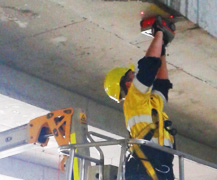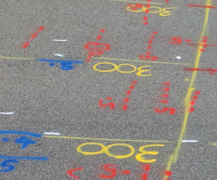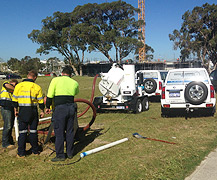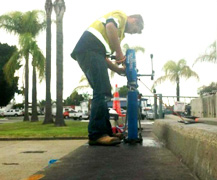GPR Concrete Scanning
We recommend the use of Ground Penetrating Radar (GPR) for concrete inspection prior to cutting and coring. We will provide you with accurate information about what is in the concrete so that you can make informed decisions. Without accurate information about what is present in the slab, drilling and cutting concrete can often be dangerous. Hitting services, reinforcement bars or post-tension cables is a costly and time-consuming error.
What we can locate in concrete:
Services & Utilities
- Locate reinforcement bars in concrete
- Locate conduits in concrete
- Locate plastic pipes in concrete
- Locate electrical conduits
- Locate copper pipes
- Locate post-tension cables
- Preparation of reports
Structural
- Identify concrete depth
- Locate voids in concrete
- Locate concrete deterioration
- Identify honeycombing in concrete
- Locate concrete beams
- Concrete assessment for rehab planning
Services
2D Scanning
2 Dimensional (2D) GPR scanning reduces the time and cost required for concrete inspection by providing real time results on site. GPR Scanning Perth employs both a handheld structural scan system that scans to a depth of 400mm, and a Utilityscan pushcart solution that scans to a depth of 4m. Survey results are marked on the ground onsite, and a report provided to the client.
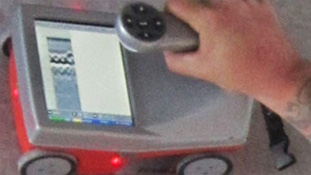 www.unitedscanning.com.au, Perth WA |
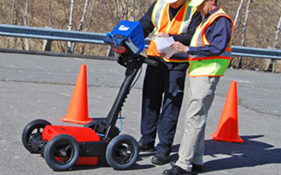 |
3D Scanning
We also provide one of the most accurate GPR scanning services available on the market – 3D scanning using a handheld Structurescan system.
Although the necessary data for 3D scans takes longer to collect, it is collated using our processing software to produce a high resolution 3D image that shows the concrete content more accurately than any other methodology.
3D Scanning allows us to build up an image of the layout of the steel bars, the condition of the reinforced steel and to verify the spacing of the reinforcement bars as well as the depth from the top of the slab and/or the bottom of the slab.
Accuracy
We often get new clients who say they have hit conduits or rebars despite having had a slab scanned using GPR. The reasons for this can normally be traced to inexperience on the part of the GPR technician responsible, or the limitations of the technology utilized.
At GPR Scanning Perth we avoid these errors by thoroughly training our operators and employing a range of different GPR technologies to vastly improve the data collection process. There is no universal “see all” GPR scanner that covers all scenarios and for that reason we deploy a variety of different devices to give our clients the most accurate information. When utilized correctly by well-trained and experienced technicians, GPR scanning has very high technical accuracy.
While GPR scanning isn’t infallible, and under certain conditions there will be limitations, for most scenarios it is by far the more accurate, safe and cost effective concrete inspection solution.
Reinforcement Bars
GPR Scanning Perth can locate reinforcement bars (reo mesh) in concrete. This is the most common application of GPR technology.
Information that GPR scanning can provide includes:
- Determine reinforcement bar spacing
- Determine reinforcement bar cover (distance between the top of the slab and the top of the rebar)
- Estimate diameter of reinforcement bar
- Identify whether there are multiple rebar mesh layers
- Identify variations in depth for reinforcement bars and mesh
- Identify safe locations for coring
Post-Tension Cables
Post-Tension (PT) Cables can hold hundreds of kilograms of tension inside the concrete slab. If cut, the release of this tension can cause the cable to break free of the concrete slab causing severe damage and loss of structural support. They will not, as sometimes suggested, break free of the building like an airborne missile, but they will cause the slab to crack, concrete to explode at anchor points, and concrete debris to break away.
It pays to be extremely wary when cutting and coring in the vicinity of PT cables, and perhaps even negligent for a contractor to do so without making any further investigation. Even when as-constructed plans are available, it is sometimes the case that cables will have shifted when the concrete was poured.
The only truly reliable method of knowing exactly what is in the slab and where it is, is by using GPR scanning. Don’t risk cutting without it.
Electrical Conduits
Electrical conduits are often embedded within concrete slabs in locations such as hospitals, shopping centres and industrial or commercial buildings. This poses a danger to contractors about to cut or core any concrete slabs.
Getting your slab scanned prior to drilling or coring will save you encountering any issues with building or facility shut-downs due to electrical outage or failure during the job. It also greatly improves the safety of the work environment for your personnel.
We will typically locate electrical services and/or conduits running within (or below) slabs with a combination of GPR Scanning and an Electromagnetic locator.
Our Services
- 3D and 2D scanning of concrete
- Concrete testing to help detect weaknesses like delamination, tanking and honeycombing
- Location of cables in concrete
- Location of utilities like electrical conduits, plastic and copper pipes
- Location of structural elements like PT cables, rebar and reo mesh (reinforcing mesh and reinforcing bars) in suspended slabs
- Non-destructive digging using vacuum extraction


